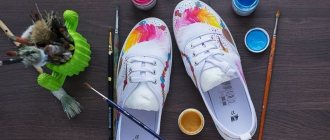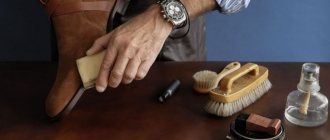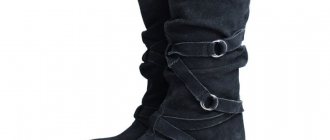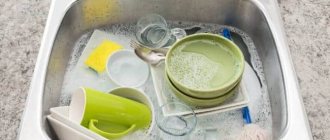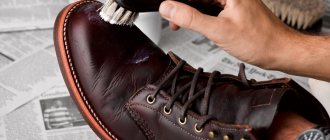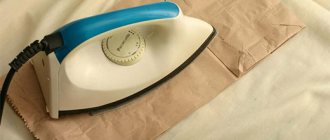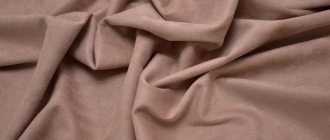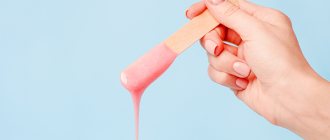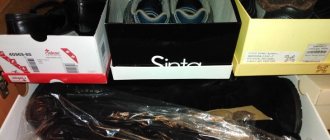Why do you need wax for leather shoes?
Wax is one of the beekeeping products from which insects make honeycombs. It is a soft, white or yellowish substance. It melts at a temperature of + 38 °C, so it is not used in its pure form. Natural or chemical solvents are used to add ductility to the shoe polish and increase penetrating power.
Wax gives shoes the following properties:
- Wax is one of the beekeeping products from which insects make honeycombs.
It is a soft substance of white or yellowish color . Waterproof. The wax penetrates deep into the skin, filling all pores and voids. Thanks to this, the products remain dry after contact with water. - Softness. The substance prevents the skin from drying out and cracking. Shoes retain elasticity and repel moisture and salts.
- Smoothness . Shoe wax fills cracks, scratches and other defects, leveling the surface.
- Presentability. The shoes acquire a pleasant matte shine, creating a positive impression of their owner.
- Resistant to damage. After treatment with the product and polishing the surface, a thin but quite durable layer remains on the products, which prevents scratches when the boots come into contact with hard objects.
Cream with wax is universal: it can be used to process both natural and artificial leather.
Where can I learn professional glassage?
Glazing is not the easiest shoe polishing technique, and mastering it on your own can take a lot of time. You can learn professional glassing in just one or two lessons from the masters of the Oxfords & Brogues shoe service. Training is available in two options: group and individual. You can sign up for a master class on glassage in our section - Training. We will be happy to reveal all the secrets to you and teach you how to professionally polish shoes!
Back to section
Add a comment Cancel reply
You may also be interested
Shoe patination is an art that anyone can learn.
07 Dec 2021
Patinage of shoes is an art that everyone can learn Patinage (patina) is another interesting way to create a unique look for your […]
Shoe glassing: professional secrets and technical nuances
26 Nov 2021
Glazing of shoes: professional secrets and nuances of the technique Glazing is a manual technique of adding a mirror shine to the toes and/or heel of shoes. […]
Cream wax for shoes
Shoe creams are products designed to maintain and restore the quality and appearance of shoes and their nutrition. They are applied after cleansing to a dry surface, impregnating it, protecting it from cracking and drying out and adding shine.
Shoe waxes are an additional care product, very similar in function to creams, but with a denser consistency. Wax applied on top of the cream will protect shoes from moisture and other negative influences even better. It can also be used independently of other products.
An important difference between such products and paints is that they are aimed more at deep protection of the material and less at updating the color, and from impregnations - that they are not suitable for nubuck, suede and other fleecy materials.
Some tips from shoemakers
- Monitor the amount of polish and water. Excess shoe polish and moisture have a negative effect on the skin.
- Do not rub the product in too hard. Movements should be light and airy. Excessive friction can damage the integrity of the layers and eventually lead to cracks.
- If you were unable to achieve a mirror shine the first time, set the shoes aside for a few hours and then finish polishing. If the glassage does not work out at all, remove the applied product with a cleaner, and after the shoes have completely dried, try again.
- After glassing, when worn, the shoes will be subject to scratches, impacts, and moisture. To maintain shine, it is enough to periodically treat your shoes with a polishing cloth and a small amount of wax. It is not recommended to use a regular hard brush to clean shoes after polishing.
Criteria for choosing wax for shoes:
- Processed material. It is important to use care products directly on the material for which they are intended. Creams and waxes are used only on smooth surfaces - natural or artificial leather. Liquid compositions allow air to pass through well and are perfect for warm and dry seasons; dense and greasy compositions form a waterproof film and protect against frost, rain and snow.
- Color. There are clear/neutral products, as well as those that add color to the shoe, mostly black or brown.
- Additional properties. Many types of care products combine several functions, such as adding shine, protecting against moisture, renewing color or eliminating scratches. In the catalog you can find detailed descriptions of the products where they are listed.
- Product release form: bottle with or without applicator. Most often, creams have a convenient soft sponge applicator and a twisting mechanism. There are also flat packages without an application device. The product made from them should be applied with a sponge or a special rag.
Why apply wax to leather shoes?
Expensive, high-quality shoes should make an appropriate impression, but without proper care they will begin to lose their luster. Visually, after treating the surface with wax, the shoes acquire a pleasant shine (even glassage) and a well-groomed appearance.
Genuine leather, like any natural material, is sensitive to temperature changes, moisture and time. Wax for English shoes Loake protects the leather and helps preserve its natural moisture, prevents the formation of creases and microcracks, which is especially important for winter and demi-season shoes.
Wax returns natural elasticity to the skin and also forms an invisible protective film.
A thin wax layer does not allow street dampness to penetrate inside, prevents the skin from getting wet through and prevents the appearance of salt deposits on boots and shoes.
Types of glassage
Of course, there is no official classification of glassage, but it can be conditionally divided into several types. Firstly, glassage can be amateur or professional. Anyone can master amateur glassage. All you need to do is purchase the necessary tools and follow the recommendations of professionals. You may have to spend at least two hours at first polishing your boots to a mirror-like shine, but once you get the hang of it, you'll be able to get great results much faster. Professional glassage requires some experience working with shoes, knowledge of the characteristics of various types of leather and products. An experienced shoemaker with a good command of the technique will only need half an hour to make your boots look perfect, and the professional glass will last much longer. Also, glassage may differ depending on the place of execution. Classic glassage involves polishing only the toes of shoes, but sometimes it is also done on the heel. However, some craftsmen are of the opinion that polishing the backdrop does not make much sense, since due to constant contact with the trousers, it does not last long.
Shoe wax how to use
Applying wax has certain features due to the density of the composition and the aggressiveness of some of its components.
Applying wax has certain features due to the density of the composition and the aggressiveness of some of its components.
First of all, when a salesperson advises you to purchase wax suitable for new shoes, listen. An incorrectly selected composition can disrupt the uniformity of the color of leather shoes, especially bright colors.
Secondly, waxing is the final final step in shoe care. It must first be cleaned and dried. Find out more about caring for Loake leather shoes.
Thirdly, the dense texture of Loake wax allows for the composition to be applied in a very thin layer. For this purpose, a suitable brush is usually recommended for a certain type of product. It would be a good idea to carefully question the seller about the method of processing shoes or ask them to show you how to do it correctly.
Popular manufacturers
The most popular manufacturers of wax compositions:
- "Prize";
- "Salton";
- "Dividik";
- Saphir;
- Salamander;
- Loake;
- Kiwi;
- Niki Line.
The products have proven themselves well in temperate, cold, hot and damp climates. They are perfectly absorbed, give shoes elasticity, and protect them from drying out, hardening and getting wet. Waxes are easy to use and economical.
Compositions for shoe care are available in the form of aerosols, sprays, emulsions, creams and express sponges.
Salton
Saphir
Dividik
Salamander
Loake
Kiwi
How to make black shoe wax
If black shoes require care, which need to not only be protected, but also brought into proper shape, the wax cream recipe can be improved.
To make the product you will need the following ingredients:
- 25 grams of beeswax;
- 8 grams of rosin;
- a little soot;
- 130 grams of turpentine.
Rosin and grated wax are placed in a fireproof container, which should be placed in a water bath. After the melting begins, the mixture must be constantly stirred with a wooden spoon. As soon as the composition becomes homogeneous, remove the container from the heat and add turpentine and soot to it. Mix everything thoroughly. After cooling, the product will acquire a rich black hue and optimal consistency. All that remains is to transfer it into an airtight jar so that the cream does not dry out. It should be used in the same way as the previous product.
Water-repellent wax cream - if you need to protect your favorite boots or shoes from high humidity in order to extend their service life, you can prepare a special water-repellent wax cream. Folk craftsmen offer three main recipes for remedies that are similar in effectiveness.
Preparatory measures
Before you start processing shoes, you need to prepare them well. This rule applies to the use of any means - both folk and store-bought.
The skin is thoroughly cleaned, if it is heavily soiled, washed and then dried. If you treat dirty shoes with impregnations, the effectiveness of the process will greatly decrease. Contaminants will not allow active substances to penetrate the structure of the leather or leatherette and will remain on the surface.
How to determine the quality of shoe wax
Expensive stores, as a rule, have good customer service. A sales consultant will help you select shoes and also suggest the right care product. However, some knowledge about the features of wax production will help you determine the level of its quality yourself.
High-quality apiary wax for shoes (pressed or melted directly in the apiary)
The method of processing raw materials determines the quality of the material. In accordance with these criteria, wax is divided into groups:
- High-quality apiary wax for shoes (pressed or melted directly in the apiary).
- Press wax for shoes. It is obtained under production conditions. Wax from sushi or merva is used as raw material. Wax obtained from sushi is classified as high-quality, while wax produced from merva is considered technical. It has a dark color and lower density, making it optimal for use in the leather industry. It is especially worth paying attention to the absence of specific strong odors in Loake products made from wax of this quality.
- Extraction wax is also obtained from merva, but not by pressing, as in the previous case, but with the help of gasoline. This explains its softness, as well as the sharp, unpleasant odor from residues of gasoline, tar and fat impurities. This type of wax is used in the production of cheap shoe polishes.
- Bleached shoe wax is produced by chemical bleaching and is used in some manufacturing applications.
Thus, high-quality shoe wax can be identified by its sufficiently high density and the absence of an unpleasant odor.
Varieties
A wide range of products allows you to choose the right product that is best suited for a particular type of product. Shoe polish with wax comes in different compositions, consistencies, and a wide range of colors. To make the right choice, it is worth studying the listed characteristics in more detail.
By composition
The composition of the products and their properties are determined by the category of wax from which they are made:
- Apiary natural. It is a by-product obtained by squeezing honeycombs directly on site. This beeswax is of the highest quality. Used for the production of high-grade impregnations.
- Pressed. The material is obtained by melting down dead or abandoned honeycombs by bees. Such raw materials are dark in color and contain many foreign inclusions. Used for restoring old worn boots and other footwear.
- Extraction. The material is extracted from heavily contaminated damaged honeycombs by dissolving them in gasoline. Such products with a large number of chemicals are classified as synthetic. The finished composition has a pungent odor, is used in the production of budget products and cannot provide the same effect as products with bee wax.
Pasechny
Pressed
Extraction
By color
Wax compositions are produced in the following colors:
- black;
- white;
- brown;
- gray;
- red;
- beige;
- yellow;
- green;
- orange.
Other shades can be obtained by mixing standard formulations in a certain proportion. A separate category is colorless wax for shoes. It is used to care for new products that have not yet lost their appearance, but need protection from moisture.
By consistency
The consistency of wax-based products is as follows:
- Fluid. Liquid wax is used as an impregnation in the initial stages of leather processing. Fluid substances are well absorbed into the porous material, filling it throughout its entire volume. They are applied with a cloth or sponge.
- Thick. It is a paste-like mass, packaged in tubes or jars. Designed for regular care of products made from natural or synthetic materials.
- In the form of a spray. Available in cans where the substance is under pressure. Used for processing delicate products that cannot be rubbed with hard materials.
Thick
Spray
Liquid
Good shoe wax Salton reviews
Katru
ADVANTAGES: It softens and cares for smooth leather shoes just great! DISADVANTAGES: Lack of brush (only conditionally)
Our shoes require careful care. Especially when you have just purchased new leather boots, timely and careful care will allow you to avoid many troubles directly related to the appearance of your new item. You can, of course, take a cream, or a spray with water-repellent impregnation, but lately I’ve started to like wax. I took wax from a German company, so to speak, “for testing,” and for several months now I have been enjoying its protective and softening properties in caring for all my shoes made of leather material. The only thing is that I try not to apply it on the embossed pigskin of my boots, since the entire relief of the figured patterns becomes more holistic and uniform.
And for all smooth shoes - you're always welcome! Salton's product has a convenient metal packaging, made in the shape of a puck, but the lid is a little difficult to unscrew, which sometimes causes some inconvenience, but that's all, as they say, the little things in life. It's especially good to polish your shoes before storing them in a box. In this case, the shoes or boots need to be thoroughly washed and cleaned of minor dirt, and dried thoroughly, say, for a couple of days. And only after all this, take a shoe brush with fluffy fiber and polish your shoes until they shine! With such storage, the material from which the shoes are made will be powered by wax and mink and mineral oils, which are somehow contained in Salton wax.
In general, I didn’t really like the creams and sprays from this company, since they did not provide much-needed nutrition and softening for leather shoes, and they had a purely superficial effect...
But wax for my shoes is simply irreplaceable, due to the fact that: Firstly, it nourishes and softens leather shoes and prevents them from further hardening due to drying. (And this happens as soon as you take out shoes for the new season after storage, it seems to be drying up and, of course, there can be no talk of any decent appearance here).
Secondly, the most important property is protection from moisture, which occurs in the off-season. Wax covers our shoes with a protective film and helps them look very well-groomed, and also gives them softness.
In addition, Salton wax is also colorless, which means it can be used to polish leather shoes of completely different colors. A kind of universal remedy for any shoes.
The downside for me is the lack of any brush or sponge in the kit, but in general you can take an old brush for this and not worry about it at all. Yes, by the way, I won’t use wax often in the summer either, since wax is capable of absorbing street dust, and that looks very unaesthetic, and even disgusting.
Colorless shoe wax from Salton is sold in almost any store that sells shoes. And the cost of wax is quite reasonable - forty-five rubles, but it lasts for a very long time, the main thing is to clean your shoes well before applying it and then everything will look just “in good shape.” In general, an excellent product for caring for shoes in the mid-season. years at an affordable price!
